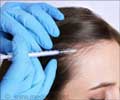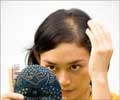Causes
Besides major illnesses, surgeries, and medical treatments like chemotherapy, there are a number of things that can cause hair loss in young people.
Here are the most common among them:
- Alopecia areata
- Traction alopecia
- Trichillomania
- Poor diet
- Aggressive hair treatments
- Life changes or trauma
- Thyroid or hormonal disturbances
- Some diseases and medicines
- Heredity
Alopecia areata
Alopecia areata is the medical term for patchy hair loss. This is the diagnosis if you see smooth hairless patches around your head. Left to themselves, the patches usually regrow hair; but in a small number of cases the condition progresses to alopecia totalis (total hair loss in the head including eyebrows and lashes) or alopecia universalis (total hair loss all over the body including underarm and pubic hair).
Alopecia areata is generally thought to be caused by an autoimmune reaction – the body’s immune system attacking its own cells (the hair follicles in this case). It is sometimes connected to thyroid dysfunctions, and sometimes to infections in other parts of the body, especially the teeth. One study at the University of Granada suggests that bacterial infections in the teeth might lead to an autoimmune reaction that attacks the hair follicles on the scalp. According to the study, the patches of hair loss are often aligned with the location of the infected teeth.
If you notice hairless patches, wait for six months to see if hair starts growing back. If it hasn’t, go for treatment.
Traction alopecia
In this kind of hair loss, the hair is literally pulled out of its roots. This happens when, over months or years, the hair is pulled tight in certain hairstyles for either practical or fashion reasons (pony tails, braids, cornrows, dreadlocks, rollers). Because the hair is always pulled tight, the follicles become damaged. After one strand of hair is pulled out, the newer hair from the follicles may be thinner and finer than previous hair. Over time, there is scarring or scaling in the area followed by permanent follicle death and baldness.
Traction alopecia usually happens in certain parts of the head, and a trained person should be able to quickly identify if this is the cause of your hair loss. Hair usually stops growing in the sides of the head, or in the region above the neck in the back of the head. It is more common among Sikh men and among African, African-American, and Japanese women who wear their hair pulled tight.
If the area of traction hair loss is rough and scaly, the prognosis is usually better than if it is shiny and smooth. Look for treatment at this stage, rather than trying to hide with hair extensions. Once the skin becomes shiny, it means the hair follicles have died.
Trichillomania
This is another very preventable cause of hair loss. Most people who habitually pull their hair have no idea how much damage this can do – some people pull out so much hair they go bald. When a doctor examines the area of hair fall, he will typically find the hair shafts are broken near the roots. The kind of damage is similar to that caused by traction alopecia, but while the hair loss is usually symmetrical in the former case, here it is in a pattern determined by the patient’s handedness. Left handed people pull out more hair from the left sides of their heads, and right handed people more from the right sides.
Trichillomania is classified as a psychological disorder, and standard psychiatric literature recommends therapy for the condition. If you cannot stop pulling hair even after finding out it may be making you bald, then therapy will definitely help. For most people, fortunately, the threat of going bald is enough to stop the habit.
Poor diet
This is again something under your control. A poor diet, especially if it is low in protein and iron, can cause your hair to fall out. Women who go on fad diets or crash diets and women with anorexia and bulimia nervosa have lifeless hair that falls easily. Vegans, (except those who consciously have a balanced diet) also usually have poor quality and thin hair – because their diet lacks the protein and calcium needed for healthy hair growth.
Healthy hair needs a healthful and balanced diet, and if you don’t have enough sources of protein and iron (which mostly come from red meats, eggs, fish and green leafy vegetables) your hair might start showing the effects of it. Nutrition experts suggest an intake of bean and gram sprouts everyday to promote healthy hair growth.
Aggressive hair treatments
Extreme hair treatments and styling lead to poor quality and weak hair. Perms and hot ironing are especially harmful in the long run, though they may make your hair look better for a short while. Dyeing and blow-drying with hot blowers can pull at roots and damage by heat and burning.
Hot oil and hot comb treatments have been associated with follicular degeneration syndrome: hair follicles in some areas become inflamed and there is a patch of diffused hair loss. Sometimes this is the precursor to scaling and baldness in the area.
Life changes and trauma
Major stresses or trauma in your life can lead to hair loss. This can be anything from childbirth, divorce, and death in the family, to job stresses and illnesses and surgery. Usually you will notice clumps of your hair falling out some two or three months after the event. The reason is that the growing hair (in the anagen phase) is suddenly shifted to the resting phase (catagen) during the time of stress. Two or three months later, hair in the catagen stage shifts to the telogen (or falling) stage, and you notice a lot of hair falling.
For childbirth the reason is hormones. The levels of the ‘female’ hormones rise during pregnancy and make your hair to grow thicker and look better. When hormone levels return to normal after childbirth, the extra hair that your scalp held on to because of hormones fall out.
The good news is that most hair fall caused by stressful events is temporary so long as you are able to cope with the stressor.
Thyroid or other hormonal disturbances
Hormones regulate hair growth and you will lose hair if they are out of balance. The thyroid gland in your throat produces hormones which regulate the conversion of testosterone to DHT (dihydrotestosterone), the main culprit in hormonal and genetic hair loss. Because it is the DHT which acts on hair follicles to weaken them so they die, an overactive thyroid can lead to hair loss. On the other hand, an underactive thyroid gland can lead to less production of sebum and undernourished hair that also falls easily. Hormonal disturbances cause polycystic ovaries (PCOS) in women, which is associated with premature balding.
Some diseases and medicines
Some diseases like diabetes and lupus cause hair loss. Many skin diseases, like fungal infections, psoriasis and eczema can make your hair fall if they affect the scalp.
Medicines can also cause hair loss: chemotherapy for cancer causes baldness. Other medicines cause less severe, but still noticeable hair loss, particularly birth-control medicines, hormone replacement therapy, and anabolic steroids. High androgen index birth control pills can trigger hair loss in some susceptible women. Low-androgen index birth control pills, on the other hand, may make your hair grow better so long as you regularly take them.
Besides these, medications for acne, arthritis, gout, depression, heart problems, high blood pressure, weight loss and attention problems can also cause less severe hair loss. Few doctors warn their patients about this potential side effect when they prescribe the drugs, and in most cases the medicines actually may not be necessary. But if you feel you are at risk of going prematurely bald, check about the medicines with a dermatologist or a trichologist (a doctor specializing in hair loss).
Some doctors also believe that weight training and taking supplements for bodybuilding can cause baldness by spiking the amount of testosterone in the body.
Heredity
Regardless of all the possibilities, most men and women go bald because they are genetically susceptible to baldness. If people in your family tend to have thin hair, and your grandparents and parents have gone bald or thinned out early, chances are that you will too. This is androgenetic alopecia. Both male-pattern baldness (balding out at the crown and forehead with overall thinning) and female-pattern baldness (diffused hair loss) are caused by androgenetic alopecia – a genetic sensitivity to dihydrotestosterone or DHT, the testosterone derivative that acts on hair follicles to kill them.
Sometimes stress and trauma trigger androgenetic alopecia. That said, losing hair in your teens or twenties is still unusual, and you should carefully check if something else is causing your hair to thin before concluding that it is genetically triggered hair loss.
Scientists have recently managed to locate the genes that cause baldness in hereditary diseases like the Maria Unna hereditary hypotrichosis (MUHH) and also hypotrichosis simplex. Babies with MUHH are born with little or no hair, not even eyelashes or eyebrows. People with hypotrichosis simplex have poor quality hair that does not grow long. Finding the genes that cause these diseases has raised the chances of finding a cure for hair loss.







